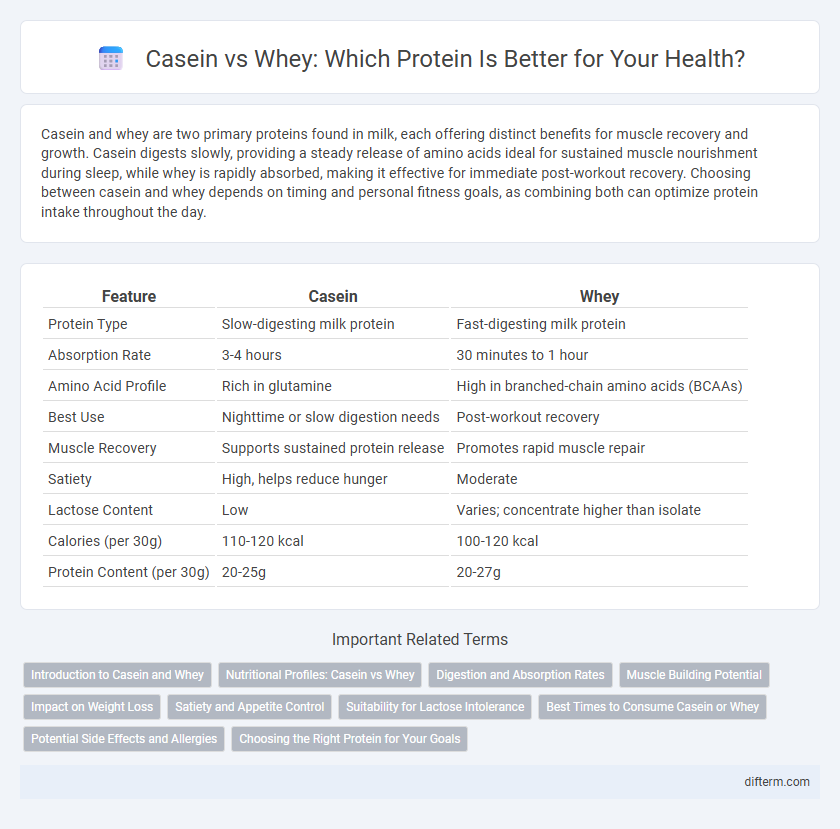Casein and whey are two primary proteins found in milk, each offering distinct benefits for muscle recovery and growth. Casein digests slowly, providing a steady release of amino acids ideal for sustained muscle nourishment during sleep, while whey is rapidly absorbed, making it effective for immediate post-workout recovery. Choosing between casein and whey depends on timing and personal fitness goals, as combining both can optimize protein intake throughout the day.
Table of Comparison
| Feature | Casein | Whey |
|---|---|---|
| Protein Type | Slow-digesting milk protein | Fast-digesting milk protein |
| Absorption Rate | 3-4 hours | 30 minutes to 1 hour |
| Amino Acid Profile | Rich in glutamine | High in branched-chain amino acids (BCAAs) |
| Best Use | Nighttime or slow digestion needs | Post-workout recovery |
| Muscle Recovery | Supports sustained protein release | Promotes rapid muscle repair |
| Satiety | High, helps reduce hunger | Moderate |
| Lactose Content | Low | Varies; concentrate higher than isolate |
| Calories (per 30g) | 110-120 kcal | 100-120 kcal |
| Protein Content (per 30g) | 20-25g | 20-27g |
Introduction to Casein and Whey
Casein and whey are the two primary proteins found in milk, each offering unique benefits for muscle recovery and growth. Casein is a slow-digesting protein that provides a gradual release of amino acids, making it ideal for sustained muscle nourishment during sleep or extended periods without food. Whey protein is fast-digesting and rich in essential amino acids, facilitating rapid muscle repair and synthesis immediately after exercise.
Nutritional Profiles: Casein vs Whey
Casein protein contains slower-digesting peptides, providing a sustained release of amino acids ideal for muscle recovery during sleep, while whey protein offers rapid absorption that quickly boosts muscle protein synthesis post-workout. Casein is rich in micellar casein, high in calcium and low in lactose, promoting prolonged satiety and bone health. Whey protein delivers a higher concentration of leucine, essential for initiating muscle growth, along with immunoglobulins that support immune function.
Digestion and Absorption Rates
Casein protein digests slowly, providing a steady release of amino acids over several hours, which supports prolonged muscle recovery and reduces protein breakdown. Whey protein is rapidly absorbed, leading to a quick spike in amino acid levels ideal for immediate post-workout muscle repair and growth. The differing digestion rates make casein suitable for sustained protein supply, while whey is optimal for fast absorption and rapid muscle protein synthesis.
Muscle Building Potential
Casein and whey protein differ in digestion rates, with whey absorbing quickly to boost muscle protein synthesis immediately after workouts. Casein provides a slow, sustained release of amino acids, supporting prolonged muscle repair and reducing protein breakdown during sleep. Combining both proteins can optimize muscle growth by leveraging whey's rapid absorption and casein's extended nutrient delivery.
Impact on Weight Loss
Casein's slow digestion rate provides a prolonged release of amino acids, promoting satiety and reducing overall calorie intake, which can aid weight loss. Whey protein is rapidly absorbed, supporting muscle recovery and boosting metabolism by preserving lean muscle mass during a calorie deficit. Incorporating both casein and whey in a balanced diet optimizes fat loss by combining sustained hunger control with enhanced muscle maintenance.
Satiety and Appetite Control
Casein protein promotes prolonged satiety due to its slow digestion and sustained amino acid release, making it effective for appetite control throughout the day. Whey protein digests rapidly, causing a quick increase in amino acids and a shorter duration of fullness, which may require more frequent intake to manage hunger. Studies indicate casein's impact on reducing calorie intake over time can support weight management better than whey when satiety is the primary goal.
Suitability for Lactose Intolerance
Casein contains higher levels of lactose compared to whey protein, making it less suitable for individuals with lactose intolerance. Whey protein isolate undergoes more extensive filtration, resulting in lower lactose content and better digestibility for those sensitive to lactose. Choosing whey isolate over casein can significantly reduce symptoms such as bloating and diarrhea in lactose-intolerant individuals.
Best Times to Consume Casein or Whey
Whey protein is best consumed post-workout due to its rapid absorption, which quickly delivers amino acids to muscles for optimal recovery and growth. Casein protein, on the other hand, digests slowly, making it ideal for consumption before bedtime to provide a steady release of amino acids throughout the night and prevent muscle breakdown. Timing protein intake according to these properties enhances muscle protein synthesis and supports overall muscle maintenance.
Potential Side Effects and Allergies
Casein protein may cause digestive discomfort such as bloating and constipation, especially in individuals with lactose intolerance or sensitivity to milk proteins. Whey protein can also trigger allergic reactions ranging from mild hives to severe anaphylaxis in people allergic to dairy. Both proteins should be consumed with caution by those with dairy allergies or sensitivities, and medical advice is recommended before supplementation.
Choosing the Right Protein for Your Goals
Casein protein digests slowly, providing a steady release of amino acids, making it ideal for muscle recovery during sleep or extended periods without food. Whey protein is rapidly absorbed, supporting quick muscle repair and growth post-workout, making it suitable for those seeking immediate protein synthesis. Choosing between casein and whey depends on your specific goals, with casein best for prolonged muscle nourishment and whey favored for fast recovery and muscle building.
Casein vs Whey Infographic

 difterm.com
difterm.com